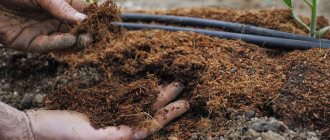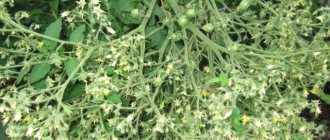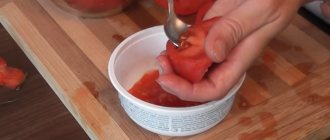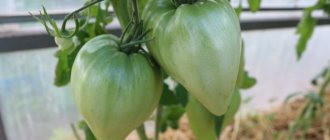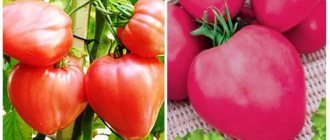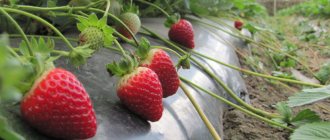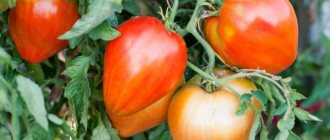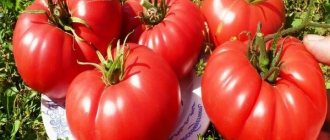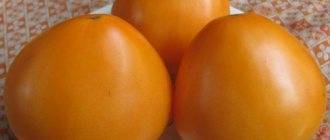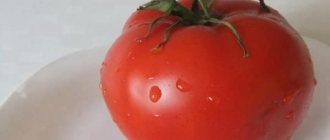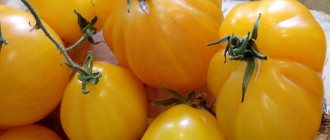Oxheart is a tomato variety with fleshy, heart-shaped fruits that are sweet in taste and similar to Mediterranean tomatoes. All fruits have an irregular shape and contain a reduced amount of juice.
| Height | Landing location | Ripening time | Fruit color | Fruit size | Origin | Fruit shape |
| Tall | Open ground | Mid-season | Reds | Large | Variety | Heart-shaped |
Description and characteristics of the tomato variety Bull's Heart, reviews, photos
The original name of the tomato is Corazon de buey .
A mid-season, indeterminate, tall tomato variety originally from Spain. In the middle zone, it is recommended to grow it in a greenhouse.
The bush is thin, up to 1.8 meters high, with a leaf of the usual type. Requires tying to the support and pinning. The best results were obtained when forming a plant with 1 or 2 stems.
Basic qualities of fruits
photo by Valentina Redko
The fruits are pear-shaped, large-ribbed, dense, red in color at maturity, weighing 250-350 grams (up to 600 g), fleshy, with granular pulp, very tasty. There are few seeds in the fruit. These tomatoes are easy to grow and transportable. Suitable for fresh consumption, making juices and sauces.
The fruits are collected in clusters of 4-6 pieces.
Diseases and pests
Perhaps one of the gardener's nightmares is late blight. A disease caused by a fungus can destroy the entire tomato crop on your site in a few days. Late blight is translated as “plant eater.” According to scientists, the birthplace of late blight is Mexico.
Most often it develops in hot weather and affects species related to tomatoes, such as eggplants and potatoes. To prevent the disease, it is recommended to burn last year’s tops on the site. Nowadays, tomato varieties have been developed that are resistant to late blight diseases, but they are also not guaranteed against infection.
For preventive purposes, it is recommended to treat the seeds using the method described above. Increased humidity promotes the spread of late blight. Therefore, when signs of the disease appear, remove the affected bushes and then burn them. Ventilate the greenhouse to reduce humidity. Treat the remaining plants with a preparation such as “Fitophtorin-M” or “Gamair” exactly following the instructions on the package.
If it is impossible to purchase the drug, you can use a folk remedy. Prepared from 10 liters of water, a liter of milk, 25-30 drops of iodine. Mix thoroughly and spray the plants. This solution is most effective for tomatoes. To prevent late blight, experienced gardeners recommend adding a glass of wood ash to each hole before planting seedlings.
Probably all gardeners will name the mole cricket as the No. 1 pest on their property. Eats everything it can reach. Prefers soils well fertilized with manure. Burrowing to a depth of about 15 centimeters, it lays about 300 eggs. In less than a month, the hatched pests emerge. If you find a wilted plant on the site, look for a mole cricket nest nearby.
You can destroy it by pouring half a liter of infusion prepared from 10 liters of water and 150 grams of hot pepper into the mink. Whitefly is one of the most unpleasant pests. This pest never appears alone. Therefore, it is impossible to view these pests. Spraying with an infusion of 150 grams of crushed garlic infused for five days in a liter of water helps effectively. Installing racks painted yellow and lubricated with castor oil also helps.
In the table below you will find links to other varieties of tomatoes presented on our website and having different ripening periods:
| Early ripening | Mid-late | Mid-early |
| Raspberry Viscount | Yellow banana | Pink Bush F1 |
| The Tsar Bell | Titanium | Flamingo |
| Kate | Slot F1 | Openwork |
| Valentina | Honey fireworks | Cio Cio San |
| Cranberries in sugar | Miracle of the market | Supermodel |
| Fatima | gold fish | Budenovka |
| Verlioka | De Barao black | Major F1 |
Features of cultivation, recommendations for care
Sowing seeds for seedlings is carried out 60-65 days before the intended planting in the ground. Seedlings dive at the stage of appearance of the second true leaf. When planting seedlings in a permanent place per 1 sq. m area it is recommended to place up to 3 plants, when forming into 1 stem - up to 4.
Further care for tomatoes consists of timely watering, weed removal, pinching, fertilizing with complex mineral fertilizer and preventive measures to protect the crop from diseases and pests.
Sowing tomato seeds
Sowing and picking:
- dilute 1 g of potassium permanganate in 0.5 cups of water;
- treat the seeds for 45 minutes, then wash;
- soaked in any growth stimulant - succinic acid, snare, humate;
- sown in containers or boxes filled with purchased soil for tomatoes;
- the seeds are laid out with tweezers into the spilled grooves, covered with soil, the distance between the seeds is 2-3 cm;
- the box is covered with glass or transparent polyethylene and placed in a warm place;
- when seedlings appear, the box is opened, the seedlings are thinned out, the box is placed on the windowsill for hardening;
- periodically the container is placed on a glassed-in loggia with an air temperature of 12-16 degrees and after a few hours is taken back to the room;
- In the 2-3 leaf phase, seedlings are planted in separate cups.
- the greenhouse is disinfected by spraying the drug Farmayod on the glass and soil or by fumigating with a sulfur bomb.
- dig up the soil on the bayonet of a shovel, adding half a bucket of humus and two tablespoons of superphosphate per square meter.
- form beds.
- seedlings are planted.
- tie up plants
- During the season, they carry out shaping, fertilizing, watering, and sanitizing against diseases and pests.
Tomatoes Heart of a bull on video
If you grew Bull's Heart tomatoes (Corazon de Bue), please write whether you liked them or not. What was the yield and taste of the fruits like under your climatic conditions? How do you assess the resistance of a variety to diseases? If possible, attach a photo of the entire bush or individual fruits you grew. Thank you!
Your reviews of the Bull's Heart tomato and additions to the description will help many gardeners evaluate this variety and decide whether to plant it or not.
The culture has many subspecies and varieties. The Bull's Heart tomato is considered medium-late and productive. It gained popularity for the structure and taste of the pulp and the size of the fruit.
Existing subspecies
Bull's heart is an old variety, very popular and loved by most summer residents. Due to the great interest in the variety, many of its subspecies have appeared with fruits of different colors and stems of different heights. All subspecies are united by the heart-shaped shape of the fruit, increased fleshiness and large fruit. In the retail chain there are low-growing tomatoes with fleshy, heart-shaped fruits and a stem height of no more than 1 meter:
- budenovka,
- pink honey,
- supermodel,
- red loving heart,
- Estonian,
- pink helmet and others.
The variety Cuore Di Bue (Bull's Heart) has an attractive heart-shaped shape with strongly pronounced ribs - one of the most famous varieties in the world, originally from the Mediterranean. Now it is very popular in the markets. This is a tall plant with very sweet tomatoes weighing up to 400 grams. Designed for growing in greenhouses.
Fleshy and sweet, Riviera tomatoes are similar to Oxheart in their elongated shape, but this variety is taller and its fruits are smaller (about 80 g).
Origin and description of the variety
This variety is the result of folk selection and was widespread throughout the USSR. It was included in the State Register of the Russian Federation in 2003 with the right of access to all regions for gardens, vegetable gardens, homesteads and small farms. Suitable for growing in open and temporarily closed ground. Depending on the variety - mid-late or late-ripening, sometimes early-ripening.
The plant is determinate and requires staking and formation. The leaves are medium sized, greenish in color. The first simple inflorescence is laid approximately above 8-9 leaves, subsequent ones - every 1-2. The stems are 1.5-1.8 m high, growth stops after the formation of 5-6 tassels with tomatoes.
The peduncle has an articulation. The color of the fruit is red, but other subspecies may be orange, pink, yellow, white, or black. Unripe specimens have a dark green spot next to the stalk. The shape of the fruit is heart-shaped and can vary on one bush. The peel is smooth, thin, the flesh is fleshy, there are almost no veins.
The average weight of the fruit is 100-230 g, but under favorable growing conditions it reaches 1 kg. The largest specimens grow from the bottom; those located in the upper part weigh only 100-150 g.
- large-fruited;
- intended for table use, suitable for freezing;
- medium late, ripens 120-130 days after the appearance of the first shoots;
- yield 3.5-5 kg in open ground, 8-12 kg in a greenhouse;
- transportable;
- good keeping quality.
Many varietal subspecies have been developed that have slight differences in description and characteristics.
- Tomato Bull's heart golden is an indeterminate plant with round, dense fruits weighing 240-280 g. At the technical stage of maturity, the tomatoes are light green, at the biological stage they are yellow. The maximum possible yield is 13.6 kg/m².
- Bull's Heart Compact is an indeterminate, early-ripening salad variety. The tomatoes are slightly ribbed, dense, heart-shaped, red, weighing 160-200 g. In the greenhouse, the yield is 6-6.7 kg/m².
- Black ox heart does not stop growing once it reaches a certain height; the fruits ripen quite early and are used for salad purposes. The surface is slightly ribbed, weight is 350-400 g, the peel is purple-red in color. In closed ground, the yield is about 13 kg/m².
- Amber ox heart is a mid-season hybrid for salads. The shape of the tomatoes is round, slightly ribbed, and differs from others in medium density. After ripening, the peel becomes orange. The fruits weigh 350-400 g and have high taste. Productivity in greenhouses reaches 10-12 kg/m².
- In the Bull's Heart , the bush grows up to 1-1.2 m in open ground, and up to 1.5 m in closed ground. A mid-season variety from Italy. The fruits are pear-shaped, fleshy, weigh 400 g, dark pink in color. This variety is suitable for preparing salads, sauces and pastes.
- Bull's Heart Orange has a little more variation than other F1 hybrids. Mid-season tomatoes for salads; the bush does not stop growing, which should be taken into account when planting and growing. The leaves are dark green and long. The inflorescence is intermediate, the stalk has joints. The ribbing of the tomatoes is medium, the shape is heart-shaped, the color in the biological stage is orange, the weight is 300-350 g. The yield when cultivated under film is 11 kg/m².
Description
The plant belongs to the determinant type, with a mid-late ripening period. If agricultural technology is followed, the yield from one plant is 5 kg, and when grown in a greenhouse - up to 12. 5 tomato seedlings are placed per 1 m2. Seeds are collected from the most beautiful and ripened fruits.
Bush
The bush is spreading, height – 1.5 m, requires pinching. The stem is strong, with large leaves and 10 fruit clusters. The first of them is formed at a height of 8 sheets. The harvest ripens 130 days after sowing the seeds.
Fetus
Rich in color, beautiful fruits have a ribbed shape. They have a pointed tip, tasty and sweet pulp with a small amount of seeds. They are grouped in 4-5 pieces. The largest ones can be up to 1 kg. They are placed at the bottom, and the top ones grow up to 170 g.
Advantages and disadvantages
Bull's Heart tomatoes have many advantages over other varieties. Tomatoes are valued for their large fruit size and excellent taste. The meatiness, small amount of seeds and juice determine the widespread use of this variety for cooking. The large size of the fruit explains the good yield.
The collected seed material can be used for planting next year; it is only important to monitor storage conditions and not sow old seeds.
The main disadvantages are:
- height of an adult bush;
- the need for a strong and large support;
- it is required to regularly plant and form a bush;
- cracking of varieties in some varieties;
- tendency to diseases;
- capriciousness to growing conditions, a decrease in the declared yield due to non-compliance with agricultural technology.
Diseases and pests
Proper care makes Ox's heart resistant to most garden diseases. The only significant danger to the variety is infection with late blight. A fungal infection can affect greens and fruits. Symptoms appear as follows:
- darkening of flowers;
- the appearance of brownish-brown spots on leaves and tomatoes;
- leaf lethargy;
- weakness of shoots and central stem;
- plant rotting.
If signs of disease appear, it is necessary to remove all affected parts and burn them away from other plantings. Spray tomatoes with targeted chemical fungicides.
Prevention of late blight includes:
- compliance with the rules of agricultural technology and care;
- disinfection of seed material;
- disinfection of soil, containers for seedlings and greenhouses;
- spraying bushes with fungicides after replanting and flowering.
Most insects find the aroma of tomato leaves unattractive. Among the dangerous pests are wireworms and mole crickets. Pests gnaw at the roots of the Ox's heart and damage the stems.
The larvae of whiteflies and night cutworms feed on leaves and flowers. To combat insects, insecticides or folk remedies are used.
Features of growing and storing crops
Tomatoes of this variety are grown by seedlings, since not all regions have time to ripen when directly sown in open ground. Unlike other varieties, germination is required in melt water. To obtain seedlings, forcing should begin in early March. Soak the seed material until the sprouts hatch. Plant in a common container, deepening it by 1-2 cm. It is advisable to leave at least 2 cm between the seeds.
Before emergence, it is necessary to provide bottom heating of the container and an ambient temperature of +25°C. After the first shoots appear, it is important to remove the greenhouse and reduce the temperature to +16-18 °C.
Good lighting is a must. In most regions, for Bull's Heart tomatoes, you will have to install additional lighting so that the daylight hours are at least 12-14 hours.
Transfer grown seedlings to open ground only after the soil has warmed up. In temperate climates, not all subspecies of this variety have time to ripen, so it is recommended to first transfer the seedlings to greenhouses and greenhouses.
It is necessary to first prepare the soil and carry out disinfection, since the variety is susceptible to infectious diseases. Planting scheme: 2-3 bushes per 1 m², row spacing of at least 70-80 cm.
Growing Bull's Heart tomatoes should be produced in diffused light, since direct sunlight can leave burns on the above-ground parts, and in the shade the bushes stretch out, the yield is greatly reduced, the plants get sick and die. Installation of support for growing shoots is done in advance.
The formation of a bush is carried out in 1-2 branches; in the south it is permissible to leave 3 . The Bull's Heart tomato variety requires pinching. There are usually few extra leaf blades, but growing stepsons can reduce the yield, because instead of feeding the fruits, the plant will grow green mass.
A feature of agricultural technology is also the need for manual pollination. It is recommended to mulch the soil surface to reduce the frequency of watering and protect the root system from sudden temperature changes that negatively affect the entire plant.
Features of care
To increase the yield of tomatoes, it is recommended to follow the care rules listed below.
Watering
Watering begins only after the seedlings have taken root in the soil. It is correct to water once a week, 5-7 liters per 1 square meter. meter. Gradually, as the plant grows, increase the amount of water to 12-15 liters per 1 square meter. meter. Water in the morning or evening, using settled water. It is necessary to water at the root so that moisture does not get on the leaves and stems.
Comfortable temperature for the growth of Ox heart is 20-22°C.
A week after planting the seedlings, a bush is formed into one stem and tied to the supports with special pieces of fabric.
To maintain moisture in the soil near the bush, it is recommended to place straw around the stem; the layer should be approximately 4-5 cm thick.
Loosening
To allow the roots to breathe, it is necessary to loosen the soil around the stems. Loosening should be done after each watering. In the first 2-3 weeks after planting, they loosen to a depth of 10-12 cm, then, in order not to damage the roots, to 5-8 cm. Thanks to loosening, the temperature and humidity conditions of the soil improve.
Stepsoning
A shoot is a shoot between the main stem of a plant and its leaf. To get a good harvest in a short time, you need to trim off excess stepsons so that nutrients are spent not on stem growth, but on fruit growth.
First, each bush is selected and the three best stems are left, and the rest are cut off. All subsequent stems are also removed when they grow 5-7 cm long.
In order for the fruits to be of high quality, you need to leave a maximum of 8 branches with fruits on the bush.
To prevent the stepsons from growing too quickly, you can leave a 1 cm long stump when cutting.
Pest treatment
Like other garden crops, tomatoes are spoiled by parasites and pests. Here are some of them:
- Late blight is a fungus that attacks the stem, leaves and fruits of tomatoes. Brown spots appear on leaves and fruits. To prevent disease, spray the plant with a garlic solution, and for prevention - with a solution of table salt. Bordeaux mixture helps well, but it cannot be used often - no more than 5 times per season. Solutions of foundationazole and phytosporin also help well;
- macrosporiosis is another type of fungus. When affected by this disease, leaves and stems begin to die. Black spots appear on the fruit near the stalk. They should be treated with a copper-soap solution, which is prepared by mixing 20 g of copper sulfate and 200 g of soap with 10 liters of water. The affected parts of the bush are cut off and burned;
- Fusarium wilt usually affects young plants in greenhouses. The leaves in the vein area become lighter, and the entire leaf gradually turns yellow. As the disease develops, the plant poisons itself with toxins. The disease can occur when the temperature in the greenhouse is not maintained. Spraying with foundationazole or phytosporin helps.
Features of the variety Bull's Heart early
This variety, like all others, has its own characteristics, which are taken into account when choosing seeds for planting.
Characteristics of the variety:
- productivity – high;
- ripening time – early (85-100 days);
- fruits are large;
- indeterminate;
- immunity – high;
- stem height – up to 180cm;
- consumption – fresh, juices, salads;
- stem formation 2-3;
- place of cultivation - open ground, greenhouse.
Description of the fruit:
- shape – heart-shaped;
- size – large;
- color – raspberry pink;
- weight – 300-800g;
- taste – sweet;
- pulp – juicy, fleshy;
- few seeds.
Advantages of the variety
The described disadvantages are insignificant and pale in comparison with the obvious advantages of these fruits:
- incredible taste, fleshy pulp;
- a bountiful harvest;
- the fruits ripen successfully when removed without losing their taste;
- they do not use purchased seeds, but those grown independently, since this variety is not a hybrid;
- high seed germination;
- beneficial properties of fruits.
The fruits contain elements beneficial to the human body, namely:
- vitamins B and K, which increase immunity and have a positive effect on the cardiovascular system and metabolism;
- pectin, which cleanses human organs of harmful substances, reduces cholesterol levels and the risk of cancer;
- mineral salts that are essential in the vital processes of the whole organism, for example, calcium, silicon, magnesium, manganese, iodine, iron and others;
- fiber necessary for the proper functioning of the gastrointestinal tract.
A separate advantage is the use of Ox's heart fruits in cooking: these include salads, sauces, adjika, canning, and other recipes for which the housewives' imagination is enough. A review of the reviews shows how much we love this variety. Let's list some of them.
Growing early ripening tomato varieties
Growing tomato seedlings of different ripening periods does not have any significant differences, except for the timing of planting seeds for seedlings and planting seedlings.
Planting seeds for seedlings:
- Calculation of the date of planting seeds : subtract the growing season (85-100 days) and 5-6 days for seed germination from the expected date of planting seedlings in a greenhouse or soil.
- the seeds , select healthy ones, of the correct shape (remove crooked and small ones), soak for 20-25 minutes in a light pink solution of potassium permanganate, rinse under running water, spread on a damp cloth in one layer and put in a bag, which is placed in a warm place (23°-25°). Remove the bag after sprouts appear.
- the sprouted seeds in a seedling box with prepared and disinfected soil (peat, humus, turf soil in equal parts with the addition of 1 teaspoon of potassium sulfate, superphosphate and urea per 10 liters of soil).
- the temperature at 23°-24°, reducing it by one or two degrees after a month. Seven days before planting, reduce the temperature to 19°, moving the boxes to the balcony, veranda, opening windows (no drafts).
Seedling care:
- Pick when 1-2 leaves appear.
- Seven days after picking, feed the seedlings with an infusion of humus (1 part in ten parts of water). Seven days after the first feeding, carry out the second (you can buy a ready-made mixture for seedlings and prepare it according to the instructions).
- Water regularly, without excessive waterlogging (too much moisture leads to stretching of the plant).
Transplanting:
- When 8-10 leaves and one flower cluster are formed, the seedlings are planted in a greenhouse (soil).
- Cabbage and cucumbers are good predecessors you can’t plant potatoes after nightshades . An undesirable neighbor of tomatoes is potatoes (common pathogens).
- After onions and root vegetables, during autumn digging, be sure to add organic matter (compost, humus - about a bucket), superphosphate and potassium sulfate (2 tbsp and 1 tbsp per 1 m²).
- Add organic matter (1/2 liter), potassium sulfate and urea (1 tsp each), superphosphate (2 tsp) to the wells.
- Maintain a distance of 50-55cm between bushes and 70cm between furrows.
- Water the planted plants well, cover the soil with mulch, and leave them undisturbed for 7-10 days.
- After rooting the seedlings, tie the stems to trellises and stakes.
- Further care:
- Watering should be carried out when the soil, taken from a depth of 10-15 cm, does not form a lump when compressed, but crumbles. Keep the soil in a state of moderate moisture.
- For indeterminate tomatoes, watering is not reduced during fruit ripening - the ovaries are constantly forming.
- Infusions for feeding : one part mullein to ten parts water or one part chicken manure to twenty parts water.
- 1st feeding : 10-12 days after planting in the ground with an infusion of organic matter (1 liter per 10 liters of water) and mineral fertilizers for this growing season. Apply fertilizer during watering. Mulch the soil (humus, compost).
Ox heart tomatoes: cultivation
As we have already said, not only an experienced gardener, but also a beginner in the field of agriculture can grow a tomato of the “ox heart” variety. The main requirements for caring for tomatoes of the variety we are interested in are the following:
- plant them in highly fertile and properly prepared soil;
- fertilize them abundantly with the necessary substances.
So, the ideal environment for growing tomatoes, even at the seedling stage, even as an adult plant, is black soil, which meets the following characteristics:
- it is loose;
- not heavy;
- Heats up well when exposed to sunlight.
Loose and fertile black soil is perhaps the best environment for growing tomatoes of the “Bull’s Heart” variety.
You will have to take care of fertilizers for the tomato variety in question in any case, however, if you live in places with clay or sandy soil, you will have to spend them in much larger quantities, since this is the only way to compensate for the low fertility of the environment. Organic substances that are ideal for this variety of tomato are organic substances, such as:
- manure;
- humus;
- compost;
- peat.
Let's look at the main stages of growing the tomato variety we are interested in.
Stage No. 1 – preparation
Preparations for growing oxheart tomatoes should begin well in advance, even before planting seedlings in the fall. That is why it is very important to decide on the variety of tomatoes to be planted in the future at the end of the current growing season: just to have time to prepare for the next one.
Where you plant tomatoes will be determined by the climate of the region where you are located, however, we recommend that you still choose to grow tomatoes of this variety in a greenhouse.
So, the first thing you need to determine is where to plant the tomato, which can be:
- open ground;
- greenhouse.
We recommend that you choose the second option, as it implies higher yields and protection of tomatoes from negative weather conditions. Thus, only greenhouse cultivation is suitable for the northern regions; residents of the south can grow “bull’s heart” in open ground.
So, after you determine the planting site, you will need to treat it from pests and diseases. For this:
- the earth is spilled with either boiling water or a solution of potassium permanganate in order to destroy the diseases and pests living in it;
- if you prefer a greenhouse, then you need to clean its walls from dirt with water and soap, and then spray them with a solution of copper sulfate;
- at the end of this preparation stage, the greenhouse is treated with a sulfur smoke bomb, which is ignited inside the greenhouse with the doors closed, since the smoke emanating from it is dangerous not only for tomato pests, but also for humans.
Treatment of the greenhouse with a sulfur bomb can be done in the autumn after completing all other work related to the elimination of parasites and diseases that wanted to overwinter in the soil of your greenhouse
After clearing the space and getting rid of pests, you can proceed to the next part of the preparation, presented:
- digging up the earth;
- soil fertilization.
Decide for yourself what fertilizers to use for the soil under the “bull’s heart”; we once again recommend that you stick to organic matter. So, it is best to dig into black soil or other soil while digging it:
- manure;
- humus.
Digging should be carried out to a depth of approximately 20-25 centimeters. The loose soil remains in this form for the winter, and the next stage is to sow tomatoes for seedlings.
Digging up the earth
Stage No. 2 - sowing and growing seedlings
The ideal month to start working on seedlings is March, or rather, its very beginning. Before sticking small grains into the ground, you need to heal them using:
- disinfectant solution of potassium permanganate;
- phytosporin.
After the processing is completed, the seeds are buried in pre-prepared soil for seedlings to a depth of approximately 3 centimeters.
Tomato picking should be done carefully, having previously moistened the soil of the plant being transplanted, so as not to damage the root system of the future bush.
As soon as the first 2-3 true leaves appear on the emerging sprouts, it is necessary to carry out a dive - transplanting the seedlings from a common box into separate pots to give them more space for development. At the same time, if you planted tomatoes with a reserve, you need to pay attention to the development of their root system. Thus, weak plants with a small root system can be weeded out, while strong ones should be preserved.
In order for the seedlings to be healthy, they should be fed at this stage of growth. A suitable fertilizer bundle in this case would be:
- wood ash;
- any liquid organic fertilizer.
To get strong tomatoes, they need to be used at the same time; one pot of the plant will require a handful of ash and a certain amount of nutrient liquid (see instructions).
A few weeks before planting tomatoes, you need to start hardening them - take them out onto the balcony for a while, letting them get used to:
- chill;
- ultraviolet;
- other uncomfortable phenomena.
Hardening of seedlings can begin in April, and even earlier, however, it should be remembered that hardening is a temporary stress. If you leave plants on the balcony overnight, in the morning you will find only dead sprouts
However, it is not worth keeping tomatoes “in the black body” for a long time; just a few times are enough for them to be ready to end up in the ground, whether in a greenhouse or open.
Prices for Fitosporin
phytosporin
Stage No. 3 - planting seedlings and caring for tomatoes during growth
As for the timing of planting seedlings, they will vary depending on the climatic conditions characteristic of a particular area of potential growth of these tomatoes. So, if you are in the middle zone of the country or its northern regions, then planting tomatoes is definitely carried out only in a greenhouse. So, if you have a heated greenhouse, planting can begin as early as April; if there is no heating, the soil in the greenhouse will warm up sufficiently by the end of May.
Seedlings must be planted in such a way that there are no more than 4 sprouts per 1 square meter, so that the subsequently formed bushes have enough space to grow.
Tomato planting is a must, otherwise you will end up with an infertile bush and will not be able to enjoy its full potential.
In these tomatoes, you can form a second stem using the first stepson, however, excess stepsons and leaves must be removed regularly, and not just once, as with many other varieties of tomatoes.
Make sure that there are approximately 8 brushes per stem, this is the optimal amount for this variety. To get a good harvest, you must regularly:
- watering the plant using heated water;
- feeding the bushes with fertilizers suitable for this variety.
If the plants should be watered approximately once every 5 days, then they only need to be fed approximately 3 times during the growing season.
It would also be optimal to carry out the hilling procedure, which consists of pulling the soil to the oxheart tomato bushes in such a way that pyramids are formed around the stem. This should be done when the root system of the seedlings is strengthened.
It is best to hill up tomatoes at least 3 times per season, this way you will help the bushes to form additional levels of roots that will more actively absorb nutrients and transfer them to the fruits
After hilling, it is necessary to water not directly at the root, but into the grooves formed due to the hilling of tomatoes between the rows of bushes.
Tying the bushes is another important step. These plants turn out to be quite heavy, and to prevent their stems from breaking off, even at the growth stage, after the seedlings have rooted, it is necessary to tie them up using:
- special garden clamps;
- old nylon tights;
- soft fabric or other devices for tying.
The garter must be done carefully, so as not to break the stems or damage the skin of the plant, on the integrity of which the general condition of the plant largely depends.
After you have completed all the basic procedures, you will only need to regularly water and feed.
Feeding tomatoes during the growth period can be done not only using manure, humus or compost, but also industrial fertilizers from various manufacturers
It is best to draw up a kind of gardening plan in advance, which will mark specific time periods during which you will fertilize, using all the same organic matter, as well as industrial fertilizers saturated with substances such as:
- nitrogen;
- potassium;
- phosphorus.
The plant needs the elements mentioned above to form tasty fruits and produce a bountiful harvest for you, so don’t skimp on fertilizers, but don’t overdo them either.
Pay attention to an interesting fact: sometimes pollinating insects do not visit tomatoes actively enough, as a result of which you risk being left without a harvest at all. To prevent this from happening, you can:
- plant honey-bearing flowers in the spaces between the rows, attracting bees and bumblebees with their scent;
- Hill up the tomatoes yourself by gently shaking the flowering bushes, or tugging at the fabric used for garter.
To get a big harvest, you need to pollinate flowering bushes, either by attracting insects to the greenhouse, or yourself, but very carefully so as not to break the plants
Provided you do everything correctly, pollination will be as efficient as possible. By the way, in order for the pollen to work even more actively and the ovaries to form for sure, you can periodically spray the bushes.
Prices for fertilizers for tomatoes
fertilizer for tomatoes
Tips for growing tomatoes:
- Elongated and pale green seedlings occur when there is a lack of urea (one tablespoon of urea per ten-liter bucket). After feeding, put it in a cool place, with a temperature of 8°-10°, for a week, do not water it during this time. Then return to the previous conditions.
- To preserve the first buds, spray the seedlings with a solution of boric acid (1 g per 1 liter of water) 4-5 days before transplanting. Carry out the treatment in the absence of sun.
- Water only with warm water once a week (5 liters per 1m²) until flowering, 10-15 liters per 1m² thereafter.
- Remove brown fruits regularly to give the rest a chance to ripen.
- It is not recommended to grow cucumbers and tomatoes in the same greenhouse at the same time : tomatoes like a lower temperature than cucumbers and need to be ventilated, but drafts are contraindicated for cucumbers.
- Be sure to prun the bushes and not thicken the plantings. It is better to form bushes into one stem.
- Remove leaves only if there is a large volume of green mass, and yellow, dry, diseased leaves must be removed.
- If bushes grow strongly, reduce the amount of nitrogen fertilizers and increase the amount of phosphorus fertilizers.
Care
Watering
Tomatoes do not like severe droughts and excess water. Therefore, they need to be watered only when the soil dries out. It is enough to do this once every 10 days. During the formation of ovaries on the bushes, the plants are watered several times a week.
It is recommended to water tomatoes using the drip method, as this helps increase productivity. At the same time, you need to add a little ash to the water so that the bushes grow better and get sick less often.
Top dressing
You need to fertilize tomatoes at least three times a season. To do this, it is recommended to use fertilizers that contain little nitrogen and a lot of phosphorus. You can also feed the bushes with macrofertilizers: boron and magnesium. They strengthen tomato flowers and prevent them from falling off.
Formation of bushes
This variety of tomato must be formed into one stem. Stepsoning is carried out when a large number of stepsons appear on the bush. They need to be removed before they grow to 4 cm in length. First, the stepsons are planted under the tassels. If this is not done in time, the tomato will shed its ovary and flowers.
You need to carry out pinching constantly, no matter how many stems you need to leave. The only limitation is that you cannot prune grown bushes in hot weather, since under such conditions they do not cope well with injuries. In summer, pinching is carried out only in cloudy and rainy weather.
Advantages and disadvantages of the variety
Indeterminate tomatoes are popular due to the advantages characteristic of these varieties:
- indents are more productive, bear fruit before frost, forming new clusters throughout the season (longer in a greenhouse);
- efficient use of planting space due to high plant growth;
- gartering the bush creates conditions for uniform illumination of the entire plant, for convenient treatment against infections;
- in areas with a warm climate they can produce a good harvest without pinching and stem formation;
- good taste, allowing you to consume it fresh and prepare juices and lecho;
- high productivity;
- low susceptibility to diseases.
Flaws:
- construction of trellises for garters, digging in pegs;
- removal of side shoots (stepping);
- impossibility of preservation in its entirety due to the large size of the fruits (preservation of cut fruits is possible).
Caring for tomatoes during cultivation
After you have planted correctly, you should take care of watering and aerating the soil. It is also necessary to build a support for tomato bushes in a timely manner.
How should watering be?
Tomatoes need to be watered abundantly during the period of fruit formation. In this case, you need to water so that moisture does not fall on the leaves. As a result, they are affected by fungal diseases (excessive air humidity also leads to disease). Only warm water is used for irrigation!
The following points must be read carefully, otherwise you may destroy the plants, both at the beginning and during the period of fruit ripening.
If you flood tomato seedlings, they will begin to stretch and become deformed. In this case, the trunk will not have time to compact, and the plant may break due to its own weight.
Important! With excess humidity and lack of heat, shoots begin to grow vigorously to the detriment of fruiting.
A lack or excess of moisture can be determined by the color of tomato leaves:
pubescent dark green leaves
- lack of moisture;
overgrown leaves are pale green
- excess moisture.
Thus, improper watering can negate all feeding and caring for the plant.
Mulching and fertilizing the soil
Many gardeners are interested in what to feed the “Ox Heart” tomato and how to add mulch to get the best harvest.
Tomato "Bull's heart" is fed 2 times per season. The first subcortex is carried out 19-20 days after planting the seedlings. The second - 19-20 days after the first, during the fruiting period.
Liquid fertilizer is applied in the form of fertilizer. To do this, take 15 g of potassium fertilizers, 25 g of nitrogen and 40 g of phosphorus per 10 liters of water. For the first fertilization, the consumption is as follows: 10 liters per 15 bushes. For the second feeding - 10 liters per 7 bushes.
To prevent the development of blossom end rot, plants are sprayed with a solution of calcium nitrate once a week. Spraying is carried out during the period of fruit growth.
You can also use dry fertilizers, which are applied between the rows (5 g nitrogen and 10 g phosphorus per 1 sq. m.).
Important! Excess nitrogen fertilizers lead to plant disease and shedding of ovaries.
Let's look at how a lack of fertilizer affects the color of the leaves. With a lack of potassium , the leaves curl and a drying border appears on them.
.
Lack of nitrogen - the leaves become dull with a grayish tint.
If a tomato lacks phosphorus, the underside of the leaves turns purple. They press against the trunk and rise up.
With a lack of magnesium,
the leaves turn marbled.
Fertilizers have been applied - now you can start mulching the soil.
Tomatoes need to be mulched for several reasons:
- to retain moisture in the soil;
- to get rid of weeds;
- to protect roots from overheating or hypothermia;
- so that the tomato fruits do not come into contact with the ground.
Thus, mulch performs several useful actions at once, so it needs to be placed under tomato bushes.
A huge number of materials can be used in the form of mulch: black/white/transparent film, cardboard, peat, sawdust, straw and agrofibre.
Mulch the ground immediately after planting the seedlings, laying the material so that it does not come into contact with the stem. Before laying, the soil needs to be moistened (but not too much) and loosened.
Important! When mulching the soil with sawdust and conifer bark, you need to apply nitrogen fertilizers to the layer covered with mulch, since when they decompose, these materials take nitrogen from the soil.
Correct formation of bushes
“Bull’s Heart” bushes can be formed into 1 or 2 stems.
To form 2 stems, in addition to the main one, leave one more - from the first stepson. All other stepsons and lower leaves must be removed, since the more shoots, the lower the yield (more precisely, there will be a lot of fruits, but they will be small)
.
You also need to limit the number of clusters with fruits on one plant to 8 pieces. This way you will get the largest and tastiest tomatoes.
Garter of tomato bushes
Gartering of bushes is mandatory, since tall bushes may simply not withstand the weight of the lower fruits and break (or “lie down”), after which the entire plant will suddenly rot.
The garter of the bushes is done after flowering, as soon as the fruits begin to set.
Pegs 180-190 cm high and 3-4 cm thick are used as support (the support can be lower, depending on the height of the bush). The plant is tied to the support using a rope. If a wire grid acts as a support, then make sure that the fruit passes through its holes freely.
Reviews
I planted the bull's heart early, but what I got was not early, but mid-season. The variety is good, productive, the tomatoes grew large and sweet. Only the hangers, for some reason, have not matured. Probably not enough potassium. Today I will plant again, but I will be more attentive to feeding.
Early Bull's Heart is a new variety for me, which I decided to plant last year. I grew the seedlings as usual, didn’t change anything. I planted some on the ground and some in a greenhouse to compare. The summer was rainy, and in the greenhouse the bushes grew greatly, stretched out, I had to often take stepsons and remove leaves, but outside I took stepsons less often, and the bushes didn’t stretch as much. I tied everything down: both in the greenhouse and outside. I was satisfied with the harvest everywhere, but only in the greenhouse I harvested the harvest almost until October, and outside, of course, I finished it much earlier. The fruits have grown very large and there are quite a lot on one bush (I didn’t weigh it, but I should have). My family liked the taste of tomatoes. My wife prepared delicious juices and lecho. I recommend trying this variety. Today I’ll plant it the same way - we don’t know what the weather will be like. I fed it mostly with a little bit of organic matter, since my soil is well fertilized.
Cultivation rules
When choosing Oxheart tomatoes for growing, the description of the variety must be studied thoroughly. Tomatoes go through a long growing season; in Russian conditions (especially Siberian and Ural) it is recommended to grow them only by seedlings.
First, the most viable ones are isolated from the total number of seeds. Dissolve a couple of tablespoons of salt in a glass of water to create a supersaturated solution. All the seed is thrown into it and mixed. Seeds with an embryo inside will sink to the bottom, empty ones will float up and are discarded. The remaining seed is washed and placed for half an hour in a weak solution of potassium permanganate for disinfection. Then soak in warm water with the addition of a growth stimulant (for example, Epin).
Caring for "Bull's Heart" tomatoes
Sow the seeds in soil that has been previously spilled with boiling water. You can use peat cups. The planting depth is 1-2 cm, the distance between the seeds is 2 cm. Cover the seeds with glass and place in a warm place. It is removed daily, leaving the ground open for half an hour to prevent the seeds from becoming moldy. When the seedlings hatch, the glass is removed and the seedlings are transferred to the windowsill, where there is the most sun. If the weather is cloudy or the windows only face the shady side, you will have to buy a phytolamp to provide additional illumination to the plants.
When 2-3 true leaf blades appear, the seedlings are picked to develop lateral roots. If it is grown in peat pots, this need not be done. Once every 2 weeks, fertilizers are applied for seedlings of tomatoes and peppers. 2 weeks before planting in the ground, seedlings are hardened. To do this, it is taken out to the balcony every day or left by a slightly open window. They start with half an hour, if it is not very warm outside, gradually increasing the hardening time until a full day.
In mid-April, plants are prepared for planting in the greenhouse. By this time they should reach a height of at least 20 cm. The greenhouse should be warm and have enough light. The soil is first disinfected by pouring boiling water over it or treating it with Fitosporin or Baikal-M. Holes are formed with a depth of 15 cm, according to the diagram, they are placed every meter. They put humus in them. Seedlings are planted, covered with soil, carefully pressed down and watered with warm water.
